CELL- STRUCTURE AND FUNCTIONS for Class 8 SCIENCE
Introduction
Jaisa ki hamein pata hai ki organisms living bhi hote hai aur non-living bhi hote hai. Toh iss chapter mein hum living organism ke basic structural aur functional unit ke baare mein padhenge jisko hum cell kehte hai. Iss chapter mein hum cell ki discovery ke baare mein padhenge, janege ki cell kisne aur kaise discover kiya, baad mein kya kya observations li gayi, etc. Issi chapter mein hum cell ki different characteristics jaise cell number, cell ki different shape aur size ke baare mein padhenge aur hum cell ke parts jaise nucleus, cell membrane, cytoplasm, vacuole, etc. ke baare mein bhi padhenge. Cell se organism kaise banta hai iss process ko bhi hum janege aur plant aur animal cell ke comparison ko bhi hum padhenge.
Discovery of The Cell
Cell ki discovery Robert Hooke ne 1665 mein ki thi.
Usne ek cork (part of the bark of a tree) ki thin slices ko simple magnifying microscope mein observe kiya aur usko cork slice mein partitioned boxes or compartments dikhayi diye. Boxes ka structure honey comb ki tarah tha. Sabhi boxes ek doosre se wall se separated the.
Robert hooke ne inn compartments ko “cell” kaha lekin yeh cells dead cells the.
At that time improved technologies available nahi thi isliye cell ke baare mein bahut little things pata thi.
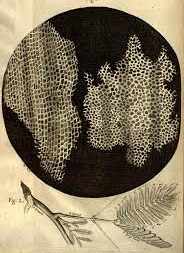
The Cell
Cell kisi bhi living organism ka basic, structural aur functional unit hai.
Cell ko bricks se compare kiya gaya hai, jaise building banane ke liye bricks use ki jaati hai aise hi living organism cells se mil kar bana hai jinke different shape, design aur sizes hote hai.
Ab hum iske different shape, sizes, etc. ke baare mein janege.
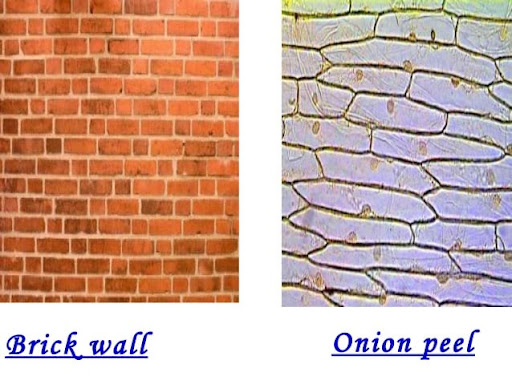
Organisms Show Variety In Cell Number, Shape And Size
Scientists ne magnifying microscopes use karke aur stains use karke cell ke structure ki detailed study ki hai. Unhone yeh bhi observe kiya hai ki ek living organism millions of cells se mil kar bana hai aur yeh cells different shape aur size ke hote hai. Inke organs bhi different number, shape aur size ke hote hai. Ab hum inke baare mein kuchh aur details padhte hai.
Number of Cells
Organisms different type ke hote hai, woh ek cell se bhi baney ho sakte hai aur bahut saare cells se mil kar bhi baney ho sakte hai.Unicellular Organism- Aise organism jo ek single cell se baney hote hai unko unicellular organism kehte hai. Eg- Amoeba, Paramoecium, etc.
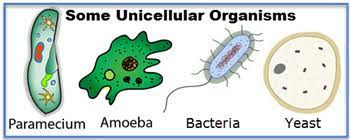
Multicellular Organism- Aise organisms jo ek se jyada cells se baney hote hai unko multicellular organisms kehte hai. Eg- Human being, dog, cat, etc. Multicellular organisms bhi apni life single cell se hi start karte hai aur baad mein divide karte hai.

Big aur small organisms mein number of cells vary karte hai lekin isse inki functioning affect nahi hoti. Single celled organism bhi multicellular organism ki tarah sabhi essential functions perform karte hai. Multicellular organisms billions aur trillions of cells se mil kar bante hai. Different cells ke different groups hote hai aur different groups of cells different functions perform karte hai.
Cells mil kar tissues banate hai, tissue se organs bante hai, organ system se organism banta hai.
Shape of Cells
Cell ke components ek membrane mein enclosed hote hai aur yeh membrane cells ko shape provide karti hai. Yeh plants aur animal cells dono ko hi shape provide karti hai lekin plant cells mein ek additional covering hoti hai jisko cell membrane kehte hai, yeh plant cells ko shape aur rigidity provide karti hai. Bacterial cells mein bhi cell wall present hoti hai.Mostly cells ki definite shape hoti hai lekin kuchh cells aise bhi hote hai jinki definite shape nahi hoti. Eg- Amoeba ki definite shape nahi hoti, yeh apni shape change karta rehta hai. Amoeba apna food obtain karne ke liye pseudopodia (false feet) banata hai aur yeh move karne ke liye bhi apni shape change karta rehta hai.
Human blood mein white blood cells (WBC) present hote hai, yeh bhi single celled hote hai aur apni shape change kar sakte hai.
Different cells ki unke functions ke according different shapes hoti hai. Kuchh cells round hote hai, kuchh long and pointed hote hai, kuchh branched bhi hote hai. Eg- Red blood cells spherical shape ke hote hai, Muscle cells spindle shape ke hote hai, Nerve cells long aur branched hote hai.
Nerve cells messages receive karte hai aur transfer karte hai aur body ke different parts ki functioning ko control aur coordinate karne mein help karte hai.
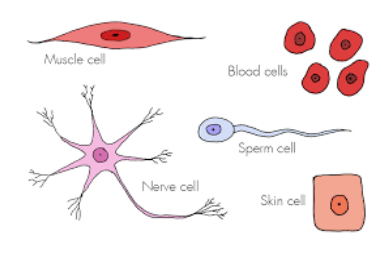
Size Of Cells
Cells ki shape ki tarah iska size bhi vary karta hai. Cells microns jitne chote bhi ho sakte hai aur centimetres jitne bade bhi ho sakte hai. Mostly cells microscopic hote hai, unko hum unaided eye se nahi dekh sakte. Unko dekhne ke liye hamein unko enlarge karke dekhna padta hai jo ki hum microscope ki help se karte hai.Smallest bacterial cell ka size 0.1 to 0.5 micrometre hota hai. Largest cell jo ki ostrich egg hai uska size 170 mm *130 mm hota hai.
Cell size kabhi bhi big ya small organism se related nahi hota woh hamesha function par depend karta hai. Eg- Elephant aur rat dono mein hi long aur branched nerve cell present hota hai aur dono mein hi nerve cell messages transfer karne ka kaam karta hai.
Ab hum cell ke structure aur functions ke baare mein padhenge.
POINT 1
Cell: The cell is known as the basic structural and functional unit of life as all organisms are composed of cells.
Cell membrane: The outermost body of the cell is called cell membrane.
Cell wall: It is an outer rigid, protective and supportive covering of plant cell.
Unicellular organisms: Unicellular organisms are those whose body consists of a single cell, which performs all functions of the body.
Multicellular organisms: Multicellular organisms are organisms that consist of more than one cell.
Cell Structure and Function
Cell kisi bhi organism ke body structure ka sabse smallest aur basic part hai. Jaise kisi bhi building ko banane ke liye hum bricks ko jod-jod kar poori building banate hai thik ussi tarah cells ko jod-jod kar ek poora organism banta hai.
Cells mil kar tissue banate hai, tissues mil kar ek organ banate hai, organs mil kar ek organ system banate hai aur organ system se organism banta hai.
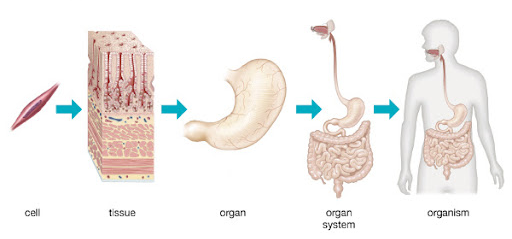
Parts of the Cell
Cells ke different parts hote hai jinko hum basic components of cell bhi kehte hai. Yeh hai- cell membrane, cytoplasm, nucleus. Ab hum inn parts ke baare mein padhenge.
Cell membrane
Cell membrane cell ki sabse outer layer hoti hai jisko hum plasma membrane bhi kehte hai. Yeh membrane cells ko ek doosre se aur surrounding medium se separate karti hai. Plasma membrane porous hoti hai aur material ko inward aur outward move karne deti hai. Hum onion bulb ki slide bana kar usko microscope mein observe kar sakte hai aur cell ke components dekh sakte hai.Onion bulb ki slide banane ke liye hamein following steps follow karne honge-
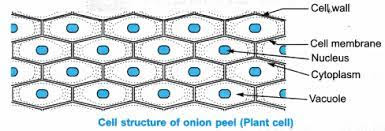
Abhi hamne plant cells dekhe ab hum animal cells ko observe karenge. Iske liye hum niche diye gaye steps follow karenge.
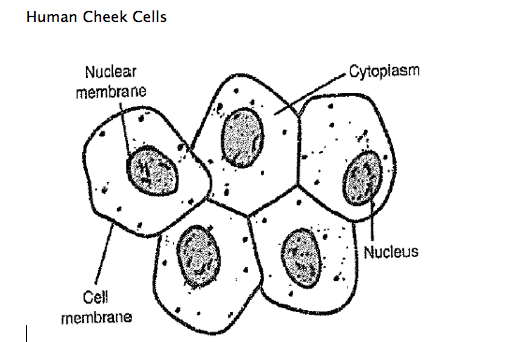
Ab hum cell ke components ke baare mein kuchh baatein jante hai.
Cytoplasm
Cell membrane aur nucleus ke beech mein jo jelly-like substance present hota hai usko cytoplasm kehte hai.
Cytoplasm mein bahut sari organelles jaise mitochondria, golgi bodies, ribosomes, etc. present hote hai.
Nucleus
Yeh generally spherical hota hai aur cell ke centre mein present hota hai. Nucleus cell ka bahut important component hai aur isko hum stain karke easily microscope mein dekh sakte hai.Nucleus aur cytoplasm ek membrane se separated hote hai jisko hum nuclear membrane kehte hai. Cell membrane ki tarah yeh bhi porous hoti hai aur material ke movement ko allow karti hai. Nucleus ke andar aur bhi small spherical bodies present hoti hai jisko hum nucleolus kehte hai. Nucleus ke andar thread-like structure present hote hai jinko hum chromosomes kehte hai.
Chromosomes genes carry karte hai jo ki body ka genetic material hota hai aur yeh parents se offsprings mein characters transfer karne mein help karte hai.
Genes- Gene living organisms ki inheritance ki unit hoti hai. Yeh hereditary characteristics ko control karti hai aur parents se offspring mein transfer karti hai.
Nucleus ek control centre ki tarah act karta hai aur cell ki activities ko control karta hai. Cell ke living substance ko protoplasm kehte hai. Isme cytoplasm aur nucleus dono hi included hote hai.
Jaisa ki hamne pehle bhi padha ki bacterial cells mein nucleus membrane absent hoti hai, toh kuchh cells aise hote hai jinme nucleus membrane present hoti hai aur kuchh cells aise hote hai jinme nucleus membrane absent hoti hai.
Aise cells jinme nuclear material without nuclear membrane hota hai unko prokaryotic cells kehte hai aur aise organisms jinme iss type ke cells present hote hai unko prokaryotes kehte hai. Eg- Bacteria, Blue-green algae, etc.
Aise cells jinme well organised nucleus hota hai aur nuclear material nuclear membrane ke andar hota hai unko eukaryotic cells kehte hai aur aise organisms jinme iss type ke cells present hote hai unko eukaryotes kehte hai. Eg- onion cells, human cheek cells, etc.
Vacuoles
Cytoplasm ke andar jo blank looking structures hote hai unko vacuoles kehte hai. Vacuoles large bhi ho sakte hai aur small bhi ho sakte hai. Mostly plant cells mein vacuoles large hote hai aur animal cells mein small hote hai.Plastids
Cell ke cytoplasm mein jo small coloured bodies present hoti hai unko plastids kehte hai. Plastids different colours ke hote hai. Kuchh plastids green colour ke bhi hote hai, unme green pigment present hota hai jisko hum chlorophyll kehte hai aur green colour plastids ko hum chloroplasts kehte hai. Leaves ka green colour chloroplast ki wajah se hi hota hai aur yeh photosynthesis ke liye necessary hota hai.Comparison of Plant and Animal Cells
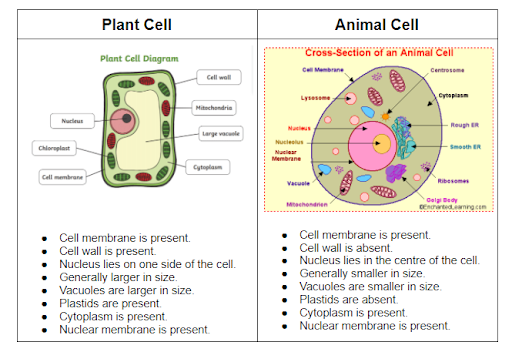
POINT 2
Chloroplast: Chloroplast is a plastid (a cellular organelle) that contains chlorophyll and in which photosynthesis takes place.
Chromosome: A chromosome is a DNA molecule that consists of a part or all of the genetic material of an organism.
Cytoplasm: Cytoplasm is a thick solution that fills each cell and is enclosed by the cell membrane.
Eukaryotes: The organism whose cells possess a nucleus bound by a nuclear membrane are called eukaryotes.
Gene: A gene is the basic physical and functional unit of heredity.
Nucleus: The spherical round body present in the centre of the cell is called nucleus.
Nucleolus: The nucleolus is a round body located inside the nucleus of a eukaryotic cell.
Plasma membrane: Plasma membrane refers to the membrane that surrounds the organelles of the cell, by creating a barrier between cell organelles and external environment.
Prokaryotes: The organism whose cells do not possess a nucleus bound by a nuclear membrane are called prokaryotes.
Pseudopodia: Pseudopodia are temporary projections of the cell membrane of eukaryotic cells.
Vacuole: Vacuoles are membrane bound transparent organelle present in both animal and plant cell.
SUMMARY
1. All organisms are made of smaller parts called organs.
2. Organs are made of still smaller parts. The smallest living part of an organism is a ‘cell’.
3. Cells were first observed in cork by Robert Hooke in 1665.
4. Cells exhibit a variety of shapes and sizes.
5. Number of cells also varies from organism to organism.
6. Some cells are big enough to be seen with the unaided eye. Hen’s egg is an example.
7. Some organisms are single-celled, while others contain large number of cells.
8. The single cell of unicellular organisms performs all the basic functions performed by a variety of cells in multicellular organisms.
9. The cell has three main parts: (i) the cell membrane, (ii) cytoplasm which contains smaller components called organelles, and (iii) the nucleus.
10. Nucleus is separated from cytoplasm by a nuclear membrane.
11. Cells without well-organised nucleus, i.e. lacking nuclear membrane, are called prokaryotic cells.
12. Plant cells differ from animal cells in having an additional layer around the cell membrane termed cell wall.
13. Coloured bodies called plastids are found in the plant cells only. Green plastids containing chlorophyll are called chloroplasts.
14. Plant cell has a big central vacuole unlike a number of small vacuoles in animal cells.